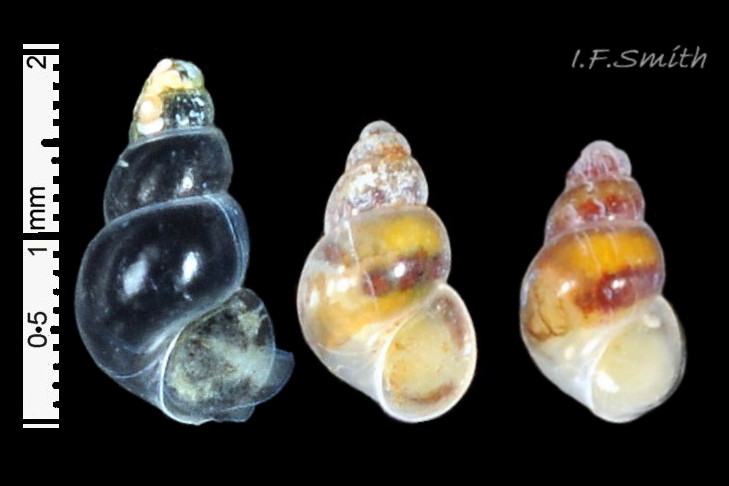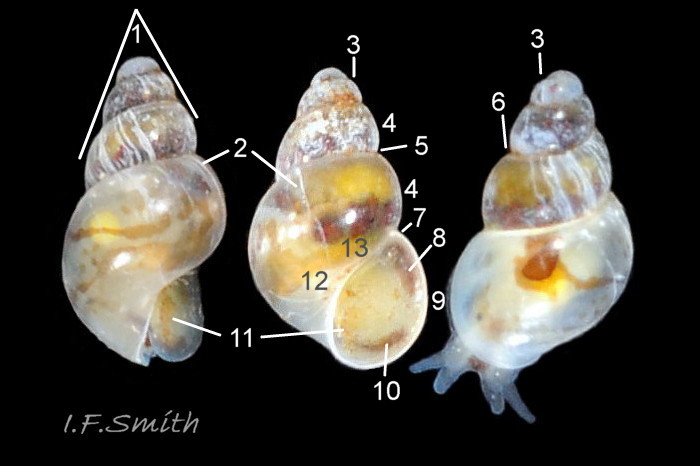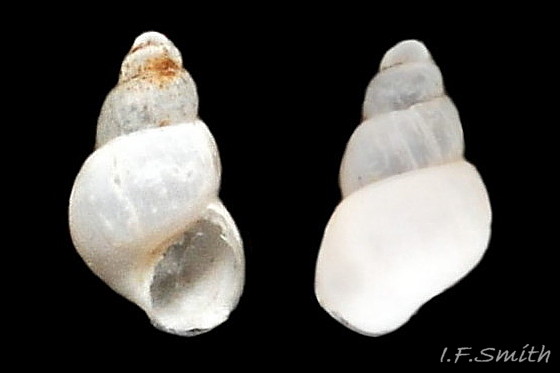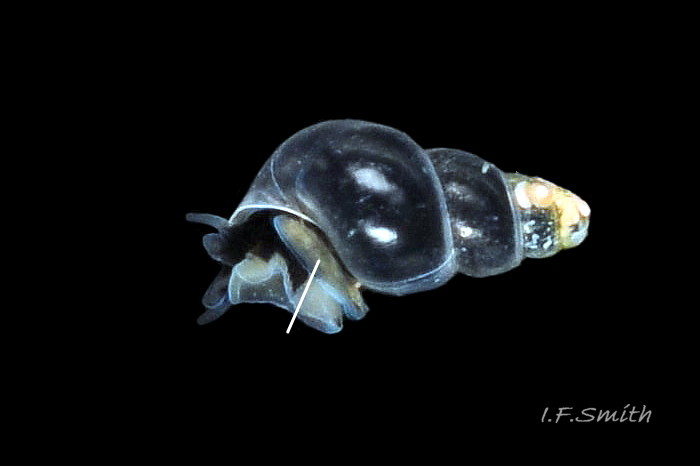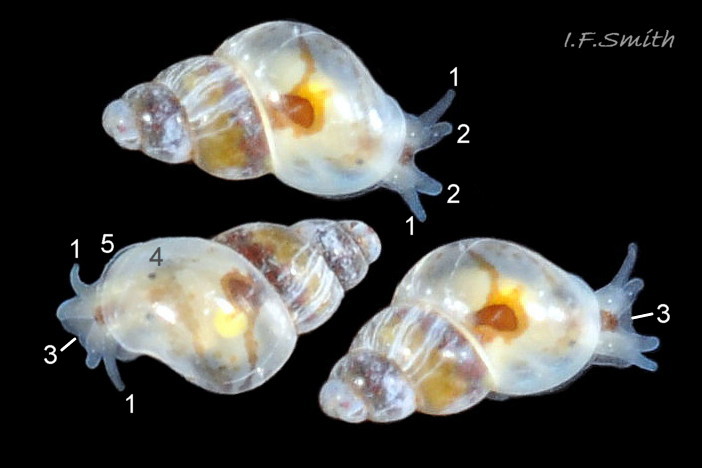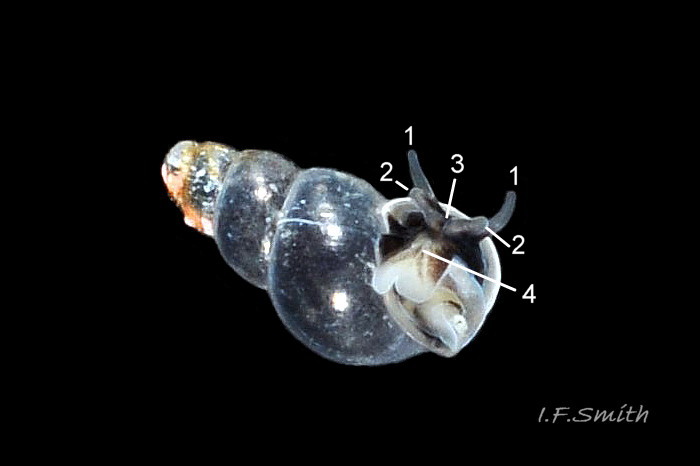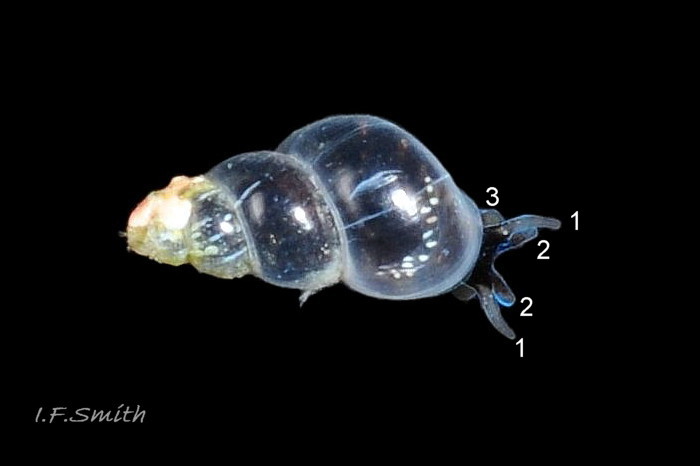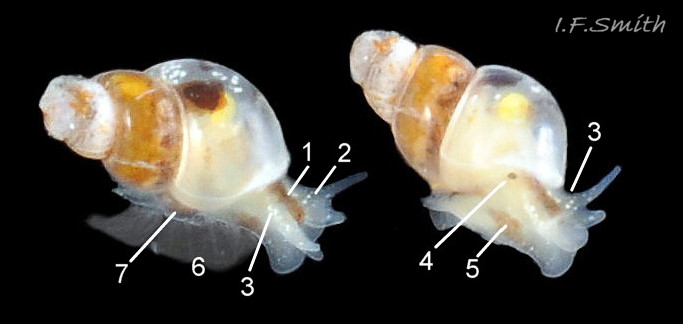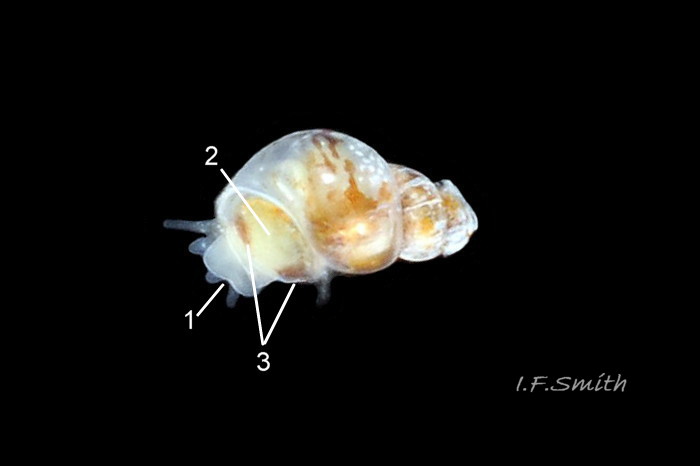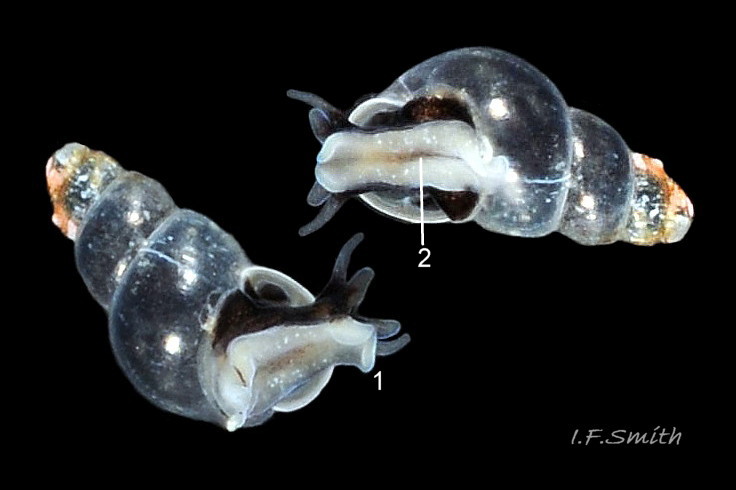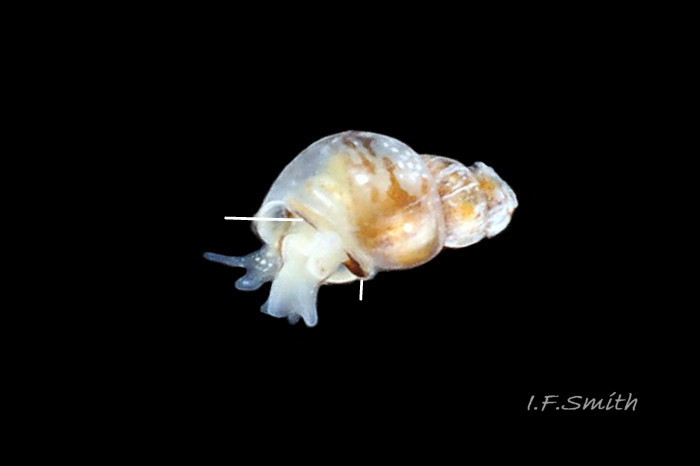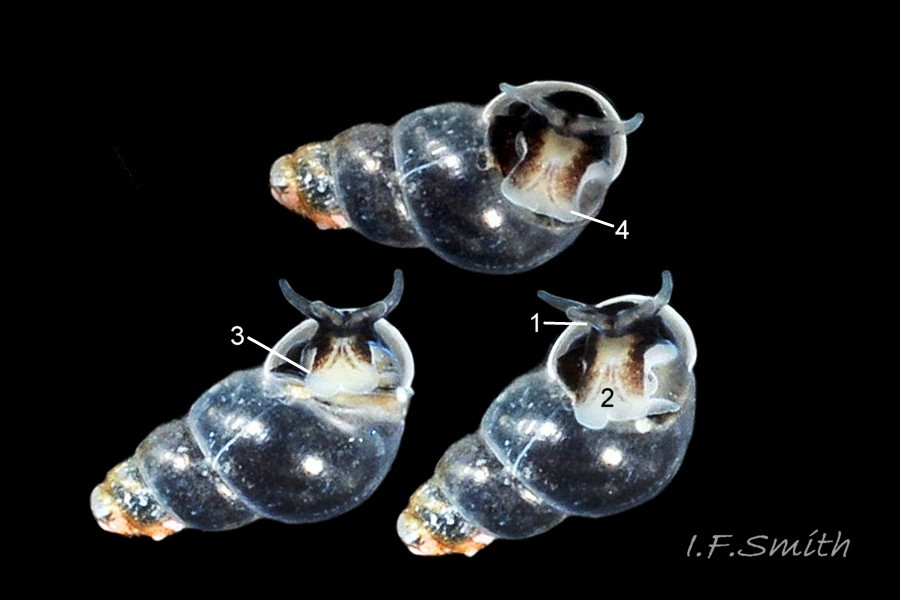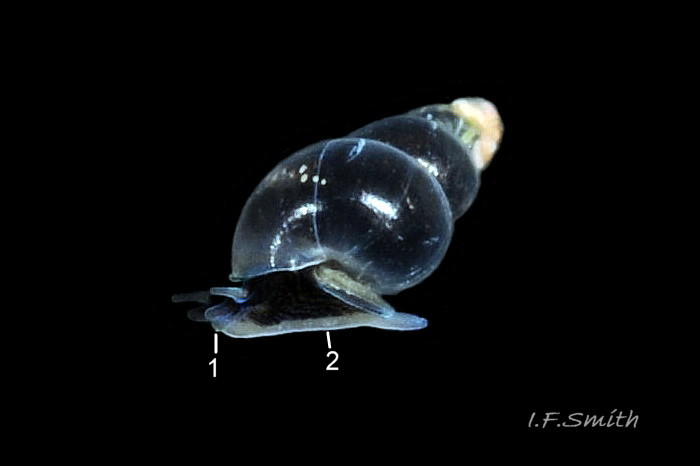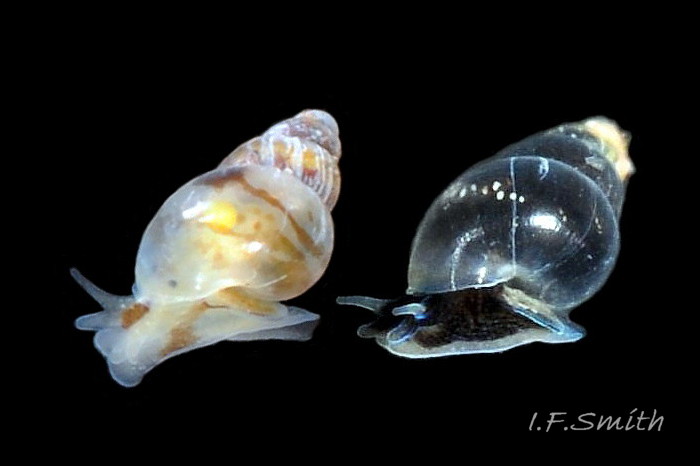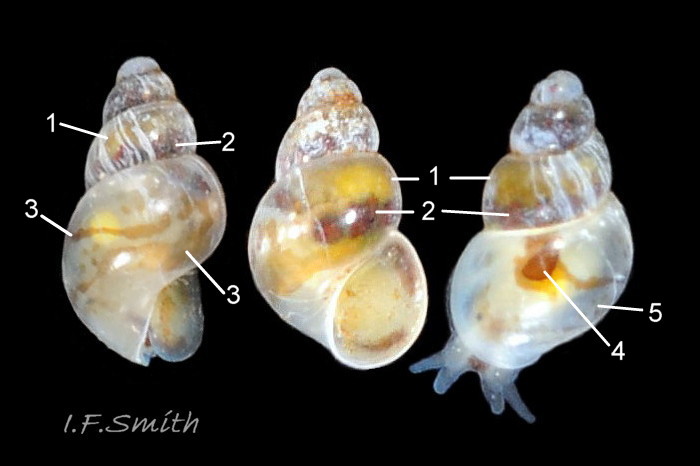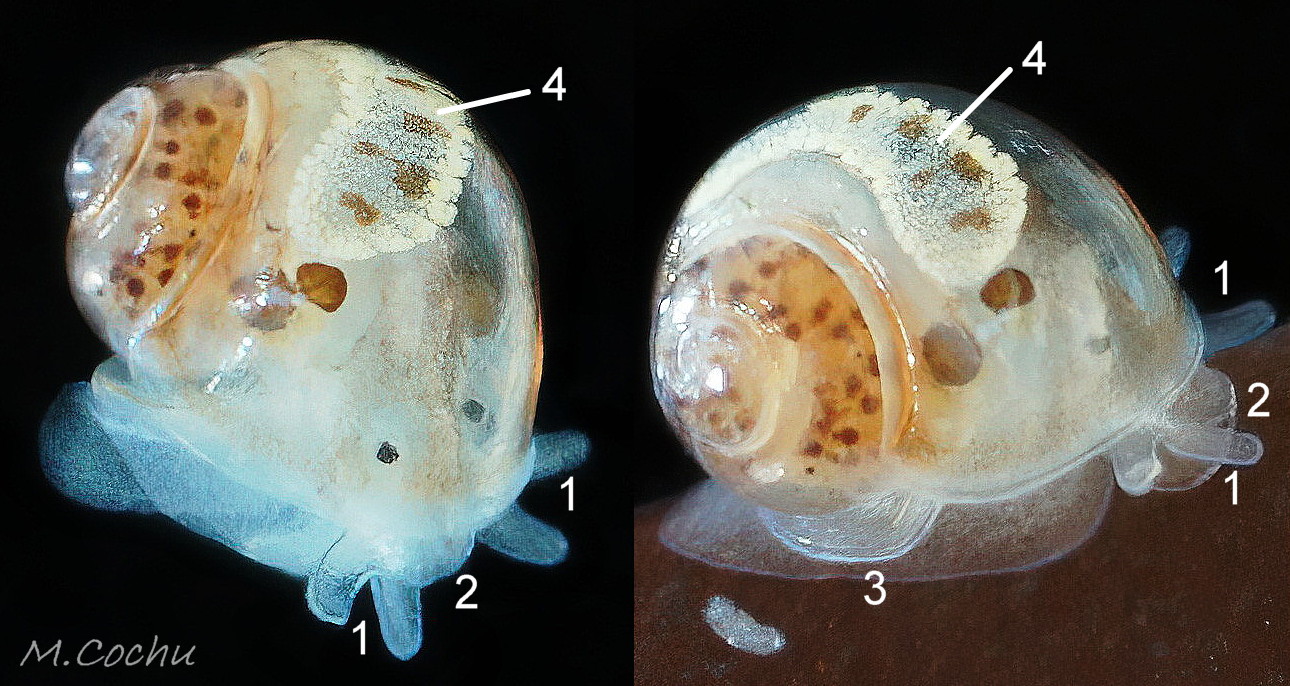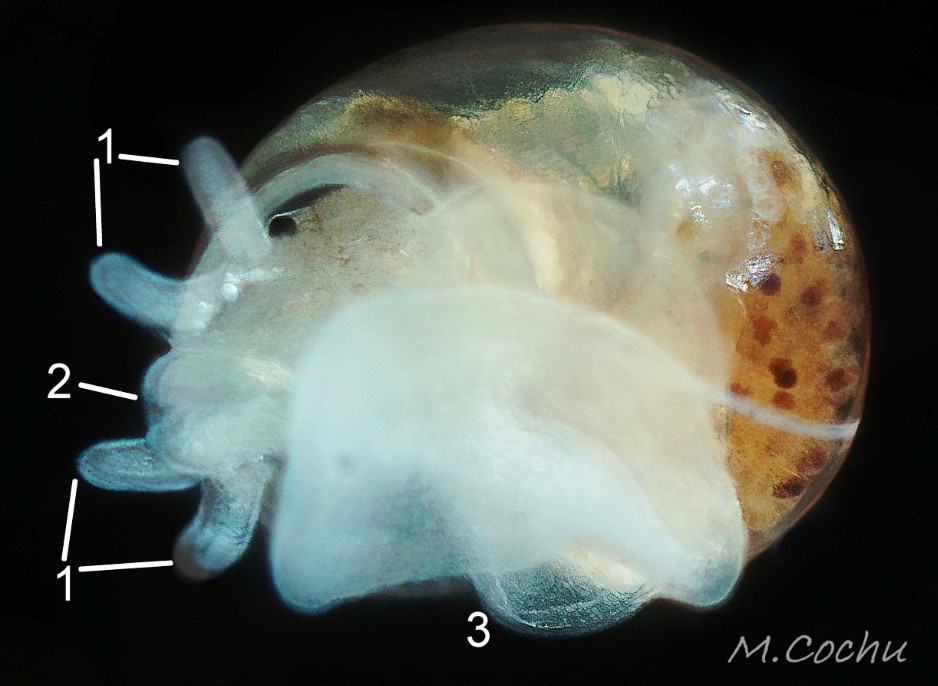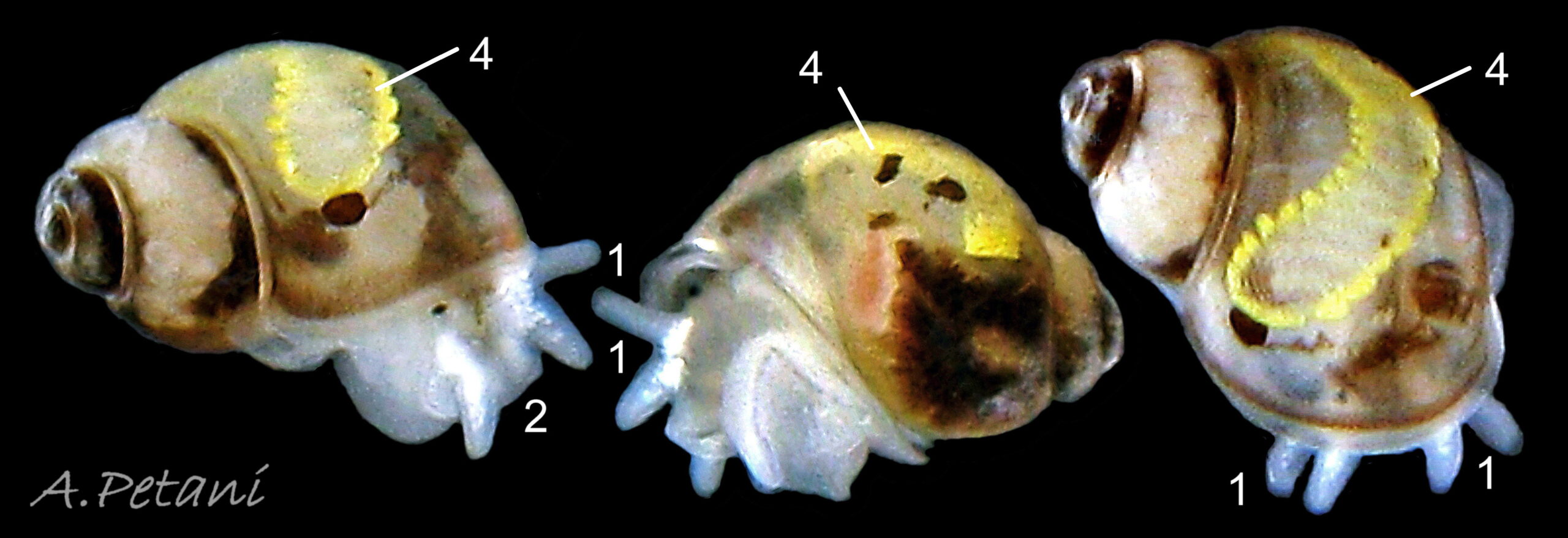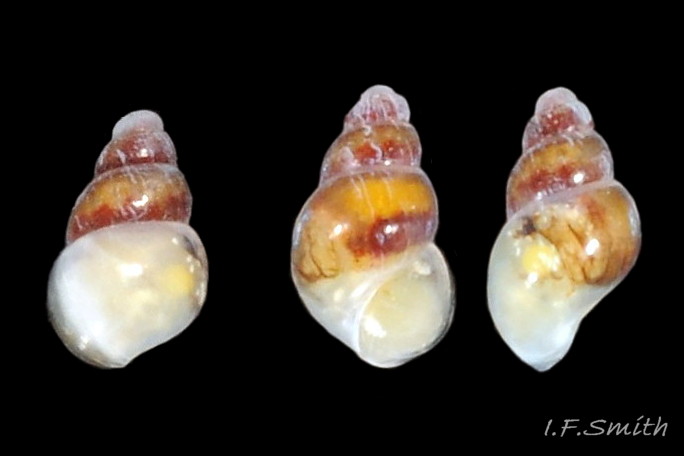Click image to enlarge with full caption. Main text below slider.
Rissoella diaphana (Alder, 1848)
Synonyms: Rissoa diaphana Alder, 1848; Rissoella glabra Gray, 1847.
Meaning of name:Rissoella= named after G.A. Risso. diaphana (Greek) = transparent, translucent.
Vernacular: Gewone dropslak (Dutch);
GLOSSARY below.
Introduction
Rissoella diaphana is a minute gastropod living on fine green and red sea weeds in rock pools, sheltered sea lochs and lagoons at marine and brackish salinities. It is unlikely to be noticed unless samples of weed are examined under magnification, preferably with a stereo-microscope at 10 to 20X. Its small size and specialized habitat may have led to evolution of some of its unusual anatomical features.
Shell description
The minute, colourless, transparent shell is usually 1-1.5 mm high and 0.78-0.85 mm wide (Fretter & Graham, 1978). Exceptionally, it reaches 1.95 mm high and 1.05 mm broad, 01 Rissoella diaphana . The shell walls are very thin and fragile. It has fine sutures distinctly defined between tumid whorls which are smoothly rounded except for a flattened, narrow, subsutural shoulder 02 Rissoella diaphana . Its profile is conical with a blunt apex formed by a protoconch which is slightly wider than the teleoconch at their juncture, causing a small bulge. The apical angle is about 50° 02 Rissoella diaphana . Its width is 54-60% of the height, decreasing with growth. The height of the body whorl is 64-75% of shell height 01 Rissoella diaphana . The only sculpture on the smooth surface is sparse growth lines. The height of the oval aperture is 36-47% of the shell height, decreasing with growth 01 Rissoella diaphana . The adapical angle of the aperture is c. 90º or a little less. The thin palatal (outer) lip curves smoothly and the slightly sigmoid edge of the columellar lip continues as the parietal lip. The columellar lip is slightly reflected over a small umbilical chink 02 Rissoella diaphana . When live, the shell is glossy, transparent and colourless, clearly showing the distinctive colours and form of the soft parts within 02 Rissoella diaphana . Vacant shells may be translucent milky-white 03 Rissoella diaphana . The oval operculum has concentric whorls around its nucleus at the middle of its columellar edge, adjacent to the umbilical chink. It is usually transparent colourless apart from a faint brownish streak on its columellar edge 02 Rissoella diaphana . On very large specimens, the operculum may be entirely translucent horn colour 04 Rissoella diaphana . The inner face of the operculum has three ribs radiating from a peg-shaped process; one in each direction along the columellar edge and a third across the centre of the operculum. On live melanistic specimens the pale ribs can be seen through the operculum, contrasting with the black flesh 05 Rissoella diaphana . On more usual specimens, the pale flesh is seen through the operculum, often with an arc of brown opercular lobe at either end of palatal edge 02 Rissoella diaphana .
Body description
The snout is so deeply and widely bifid as to resemble stout blunt tentacles 06 Rissoella diaphana .The mouth is a longitudinal slit at its base 07 Rissoella diaphana . Cephalic tentacles arise from the base of the snout; they are cylindrical, slightly tapering to blunt tips 08 Rissoella diaphana . Each eye is on a slight bulge far back from the tentacles; they are usually kept within the transparent shell 06 Rissoella diaphana and are only rarely exposed beyond it 09 Rissoella diaphana .
The long narrow foot tapers at its posterior, and the anterior is truncated with a medial embayment 10 Rissoella diaphana and a rounded flexible lobe at each side 11 Rissoella diaphana . The sole is translucent white with opaque white spots. It is divided by a medial longitudinal furrow which has at its brownish centre the posterior pedal mucous gland with a groove running to the posterior. On typical pale specimens the whitish opercular disc supporting the operculum is slightly exposed laterally as small brown opercular lobes 12 Rissoella diaphana . The disc and lobes are often visible through the transparent operculum when the animal is retracted into its shell 10 Rissoella diaphana . The bilaminate structure of the foot is clearly distinguished on melanistic specimens as the ventral sole layer is white and the dorsal layer is black. The two layers do not precisely coincide. To the anterior of the snout the dorsal layer of the foot, like the snout, is deeply and widely bifid exposing a large ‘V’ of the white sole layer 13 Rissoella diaphana . The dorsal layer can shift position relative to the sole layer, sometimes extending beyond it 14 Rissoella diaphana and sometimes retracting short of it 13 Rissoella diaphana . The anterior pedal mucous gland opens at the fork of the ‘V’ 07 Rissoella diaphana . The wide white periphery of the foot on melanistic specimens suggests that the upper-layer may not cover the sole-layer there 14 Rissoella diaphana .
The ground colour of flesh on typical specimens is translucent white with opaque white spots; usually with brown longitudinal bands on the dorsal surface of the snout, head and neck and a brown diagonal band on each side of the foot and brown opercular lobes 09 Rissoella diaphana . The extent and shade of brown varies 01 Rissoella diaphana ; some lack brown on the opercular lobes and on some the brown coalesces all over body and some others are entirely purple-brown or black. Usually, the sole, tentacles and distal half of the snout are whitish even on melanistic specimens 15 Rissoella diaphana .
The whitish mantle often extends slightly beyond the edge of the aperture 06 Rissoella diaphana . Copious mucus can be exuded by mantle 09 Rissoella diaphana . The transparent shell reveals the colours of the body within it. The hypobranchial gland consists of some groups of white and yellow granules and one large dark brown/black oval. There are various other brown and opaque white marks in the mantle, a brown digestive gland interspersed with black excretory cells, and a yellow/orange hermaphrodite gonad 16 Rissoella diaphana . There is no ctenidium or osphradium within the mantle cavity. A small penis lies in a groove on the right.
Key identification features
Rissoella diaphana
1) Shell, usual maximum height 1.5 mm, extreme 1.95 mm, conical. Height noticeably more than (1.7 to 1.85X ) the width. Aperture less than 50% of shell height (usually 36-47%). 01 Rissoella diaphana . Colourless transparent when live, milky white when vacant 03 Rissoella diaphana .
2) Conspicuous brown/black oval in hypobranchial gland is visible dorsally through body whorl of live animal 16 Rissoella diaphana (Obscured in melanistic specimens).
3) Snout deeply and widely bifid 06 Rissoella diaphana , cephalic tentacles not bifid 08 Rissoella diaphana .
4) Small, narrow umbilical chink 02 Rissoella diaphana . In marine and brackish salinities.
Similar species
Rissoella opalina (Jeffreys, 1848) 17 Rissoella diaphana , 18 Rissoella diaphana & 19 Rissoella diaphana
1) Shell, maximum height 2 mm, rounded but not as globular as R. globularis. Height a little more than (c. 1.4X) the width. Aperture height c. 50% of shell height. Yellowish brown when vacant.
2) Wide hypobranchial gland with U shaped end, visible through transparent body whorl, is yellowish or white with saturated colour in flounced margin. Scattered, variable, rounded and squared brown or black dots are also visible in body whorl on mantle and body.
3) Snout slightly bifid, but cephalic tentacles deeply and widely bifid.
4) Small umbilical chink, more obscure than on R. diaphana.
Rissoella globularis (Forbes & Hanley, 1852). See figs. 17-19 in Villari & Scuderi (2022) https://doi.org/10.31396/Biodiv.Jour.2022.13.3.717.728
1) Shell, maximum height 1 mm, globular. Height equal to or slightly less than width. Aperture height about 60% of shell height. White when vacant.
2) Brown viscera visible through transparent shell when alive.
3) Snout bifid, short cephalic tentacles not bifid.
4) Round umbilicus.
Most British records from West Scotland. Minute size may cause it to be overlooked.
Habits and ecology
R. diaphana lives on fine red or green sea weeds below MTL on rocky shores, especially in large rock pools and sites such as sea lochs and lagoons where there is shelter from strong wave action or currents that dislodge snails and their food from weed. Most records are from coasts reached by oceanic water.
R. diaphana relies on pallial respiration as it lacks a ctenidium. The kidney extends forwards into the mantle skirt where its rich vascular supply assists oxygenation of the haemolymph (blood). The respiratory current is created by strip of ciliated epithelium between the anus and mantle edge; it draws oxygenating water through the mantle cavity and expels faecal pellets and excreta.
The narrow furrowed foot with flexible anterolateral lobes 11 Rissoella diaphana is well adapted for gripping and movement among filaments of weed. The posterior pedal gland exudes mucus which is formed into a thread in a ciliated groove running to the posterior of the foot. The thread hardens on contact with sea water and is used to secure the animal and assist movement between different levels.
It feeds by grazing diatoms, algal fragments and detritus trapped by filamentous weeds. Breeding is in spring and summer. Like most heterobranchs it is a simultaneous hermaphrodite with mutual internal fertilization by short penes. Egg capsules are manufactured one at a time in the pallial oviduct. The capsules are hemispherical with a flat base which is attached to fine weed. Each capsule contains one or two ova floating in fluid. The brief veliger stage is passed within the capsule; crawlers hatching after two weeks. Subsequent growth is rapid when conditions are suitable. Several generations may coexist in summer, but in winter numbers decline and mainly juveniles are found, though occasional very large specimen, c. 2mm, found in early spring 01 Rissoella diaphana suggests that some adults may survive winter.
Distribution and status
R. diaphana occurs from Norway to the Canary Islands and into the Mediterranean. It is absent from the Baltic and there are no records from the continental coast of the North Sea, GBIF map http://www.gbif.org/species/5191465 . In Britain, it is found mainly in the west between the Isle of Wight and Orkney, but is absent from the north-east Irish Sea. There are few records from the North Sea coast of Britain, but it may be overlooked as it was found at five sites/dates in North Yorkshire in 1992 and 2014 during visits by experienced members of Conchological Society of G.B. & Ireland 20 Rissoella diaphana. U.K. map NBN https://species.nbnatlas.org/species/NBNSYS0000177731 .
Species of Rissoellidae are difficult to distinguish globally because the small shells have few useful features and there is lack of consensus on which soft-part characters are diagnostic (Caballer et al 2011). But much has been done to clarify European species by Villari and Scuderi (2022).
Acknowledgements
I gratefully thank Marc and Florence Cochu and Alen Petani for use of images, and Jan Light for a specimen.
References and links
Caballer, M., Ortea, J. & Narciso S. 2011. Description of two new species of Rissoella Gray, 1847 (Mollusca, Gastropoda, Heterobranchia) from Venezuela, with a key to the Caribbean species known for the genus. http://zookeys.pensoft.net/articles.php?id=3048
Forbes, E. & Hanley S. 1853. A history of the British mollusca and their shells. vol. 3 , London, van Voorst. (As Jeffreysia diaphana; https://archive.org/stream/historyofbritish03forb#page/150/mode/2up
Fretter, V. 1948. The structure and life history of some minute prosobranchs of rock pools: Skeneopsis planorbis (Fabricius), Omalogyra atomus (Philippi), Rissoella diaphana (Alder) and Rissoella opalina (Jefffreys). J. mar. biol. Ass. U. K. , 27 (3): 597-632. http://plymsea.ac.uk/1294/ or https://www.mba.ac.uk/nmbl/old_jmba/vol27/vol27no3.htm
Fretter, V. and Graham, A. 1962. British prosobranch molluscs. London, Ray Society.
Fretter, V. and Graham, A. 1978. The prosobranch molluscs of Britain and Denmark. Part 4 Marine Rissoacea. J. Moll. Stud. Suppl. 6.
Graham, A. 1988. Prosobranch and pyramidellid gastropods. London.
Jeffreys, J.G. 1867. British conchology. vol. 4. London, van Voorst. (As Jeffreysia diaphana) https://archive.org/stream/britishconcholog04jeffr#page/58/mode/2up
Villari, A. & Scuderi, D. 2022. Mainly Mediterranean Rissoellidae (Heterobranchia Acteonimorpha?) with the description of Rissoella camillae n. sp. Biodiversity Journal, 13 (3): 717–728. https://doi.org/10.31396/Biodiv.Jour.2022.13.3.717.728
Wigham, G.D. & Graham, A. 2022. Marine gastropods 4: Heterobranchia 1. Synopses of the British Fauna (New Series) no.63. (300 pages). Field Studies Council, Telford, England.
Current taxonomy: World Register of Marine Species (WoRMS) http://www.marinespecies.org/aphia.php?p=taxdetails&id=141147
Glossary
abapical = away from the apex of the shell.
adapical = towards the apex of the shell.
anterolateral = situated in front and to the side of.
aperture = mouth of gastropod shell; outlet for head and foot.
bifid = divided into two parts by a cleft.
Caenogastropoda = Littorinimorpha and Neogastropoda; mostly sea snails. Combined with the Patellogastropoda, they formed most of the now unaccepted Prosobranchia in the Twentieth Century.
cephalic = (adj.) of or on the head.
cilia = (pl.) vibrating linear extensions of membrane used in feeding or locomotion.
ciliated = (adj.) coated with cilia.
columella = solid or hollow axial “little column” around which gastropod shell spirals; hidden inside shell, except on final whorl next to lower part of inner lip of aperture where hollow ones may end in an umbilicus, umbilical chink or siphonal canal.
columellar = (adj.) of or near columella (central axis of spiral gastropod).
columellar lip =lower (abapical) part of inner lip of aperture.
diatom = microscopic aquatic alga with siliceous cell-walls.
ctenidium = comb-like molluscan gill.
distal = away from centre of body or point of attachment.
epithelium = tissue forming outer layer of body surface and lining the alimentary canal and other hollow structures.
haemolymph = circulating fluid in molluscs which carries nutrients, waste and hormones. Analogous to vertebrate blood, but most molluscs have copper-based haemocyanin, instead of red haemoglobin, to carry oxygen.
height = (of gastropod shells) distance from apex of spire to base of aperture.
hermaphrodite, simultaneous = individual acts as both male and female at the same time.
Heterobranchia = includes Nudibranchia, most sea slugs with internal shell and the Rissoellidae which were formerly included in the now unaccepted Prosobranchia.
hypobranchial gland = thickened, sometimes puckered, tissue on roof of mantle cavity of many gastropods. Secretes mucus to trap and consolidate particles from inhalant water. Often other biologically active compounds produced.
mantle = sheet of tissue which secretes the shell and forms a cavity for the genital and renal openings, anus etc.
MTL = mean tide level.
opercular = (adj.) of the operculum.
opercular disc = part of foot that growing operculum rests on.
opercular lobe = extension of opercular disc beyond edge of part of operculum.
operculum = plate of horny conchiolin used to close shell aperture.
osphradium = organ for testing water quality (chemical and/or for particles).
palatal lip = outer lip of gastropod aperture.
pallial = (adj.) of the mantle (a.k.a. pallium).
pallial respiration = oxygen absorbed from water by the mantle (a.k.a. pallium).
parietal lip = inner side of gastropod aperture adapically of columellar lip.
periostracum = thin horny layer of chitinous material often coating shells.
plankton = animals and plants which drift in pelagic zone (main body of water).
protoconch = apical whorls produced during embryonic and larval stages of gastropod; often different in form from other whorls (teleoconch).
subsutural = located immediately below a suture.
suture = groove or line where whorls of gastropod shell adjoin.
teleoconch = entire gastropod shell other than the apical, embryonic & larval stage protoconch.
umbilicus = cavity up axis of some gastropods, open as a hole or chink on base of shell.
umbilical chink = narrow slit-like umbilicus, often inconspicuous.
veliger = shelled larva of marine gastropod or bivalve mollusc which swims by beating cilia of a velum (bilobed flap). Stage may be passed in plankton or within liquid-filled egg-capsule.
